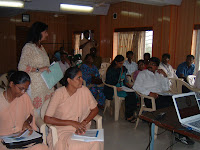The onus is on the PR person to stick to the straight and narrow


Corruption is as old as the hills, as old as the oldest profession in the world. No country is devoid of it; it varies in degrees. Unfortunately, India happens to be one of the top ten countries where corruption is the most rampant. Corruption in the media in India is also nothing new. It is not as though the Radia tapes have opened out a whole new world that was hitherto unknown. What it brought into the focus was the fact that even some of the superstars of media were dabbling in dangerous territory.
When I was heading the PR function of a large south Indian corporate group some years ago, I had conducted press conferences in all the metros. I had come across fake journalists, those who brandished fake visiting cards to gain entry and helped themselves to dinner and cocktails. At the time I wasn’t as mature as I’m today, and perhaps not as bold. So, many of these characters easily got away. It was much later that I made it a point to debar entry to press conferences of all suspicious ‘journos’. The sad part is that no PR and corporate communication person makes an effort to weed out the corrupt. For many, the more numbers at a conference the merrier. The management (of companies) in most cases is in the dark or has no clue.
I have had senior reporters asking me (especially in Bombay and Delhi) what was the gift they would receive if they attended. I made it a point not to dish out gift cheques or cash in envelopes. The PR agency suggested gift coupons. But I managed to override that and insist on gift hampers – products the company manufactured. I would tell my assistant to present the hamper to reporters as they left; most would accept, few would refuse. But the worst lot was the one that wanted the package to be sent home.
Radiatapes or not, this is the sort of malaise that all well-meaning PR practitioners and communicators must strive to eradicate. And this is what I emphasised to the participants at the CSIM-organised media workshop (refer previous blog). More than learning the nuances of good communication, it is imperative to work the right way – to be devoted to credibility, transparency and ethics. Nobody should be able to point a finger at you for a reason you cannot convincingly explain. At the end of the day, when there is credibility, there is goodwill and respect. And when you have all of that, you find communicating easier and more satisfying.
I also spoke about the cut-and-paste culture that is so much a part of writers and editors today. Plagiarism was just not on, I stressed, and said that despite computers and mobile phones, a good reporter must be prepared to do enough and more legwork. Sifting through an overload of information is difficult but what comes easy in life! There must also be a commitment to achieving perfection, to excellence, to give off your best.
Making words work is not enough for a journalist or editor. It has to be accompanied by a broad grasp of the ever-changing media scene, a thirst for acquiring knowledge, and a pledge to remain above board and earn the respect of all people. This was the overall second message I tried to hammer home.
Pictures show participants settling down before the commencement of the workshop, and the head of an NGO making a point.
Comments